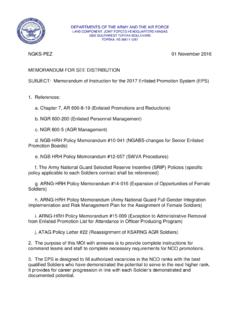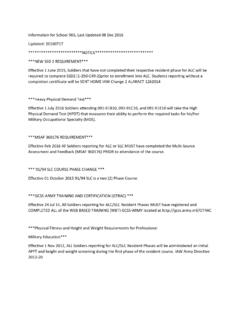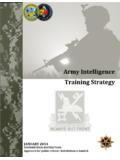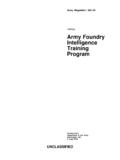Transcription of THE ORGANIZATIONAL INSPECTION PROGRAM (OIP) GUIDE …
1 UNITED STATES army INSPECTOR GENERAL SCHOOL THE ORGANIZATIONAL INSPECTION PROGRAM (OIP) GUIDE FOR COMMANDERS DEPARTMENT OF THE army INSPECTOR GENERAL AGENCY TRAINING DIVISION 5500 21st STREET, SUITE 2305 FORT BELVOIR, VIRGINIA 22060-5935 September 2013 The ORGANIZATIONAL INSPECTION PROGRAM GUIDE for Commanders Table of Contents Chapter 1 - Overview Section 1-1 - Introduction Section 1-2 - Evolution of Modern army INSPECTION Policy Chapter 2 - Policy and Terminology Section 2-1 - Inspections Publications Section 2-2 - Key Terms Chapter 3 - Approaches to Inspections Section 3-1 - INSPECTION Approaches Section 3-2 - Basic Elements of an INSPECTION Section 3-3 - Root Cause Analysis Model Chapter 4 - Developing an ORGANIZATIONAL INSPECTION PROGRAM (OIP) Section 4-1 - Developing an ORGANIZATIONAL INSPECTION PROGRAM Section 4-2 - Sample Battalion ORGANIZATIONAL INSPECTION PROGRAM Section 4-3 - Sample Division ORGANIZATIONAL INSPECTION PROGRAM Section 4-4 - Responsibilities of the OIP Coordinator Chapter 5 - Reserve Component INSPECTION Considerations Chapter 6 - Inspections in TDA Organizations Chapter 7 - Inspector General Inspections Appendix A Developing INSPECTION Checklists for General Inspections Index The OIP GUIDE for Commanders September 2013 Chapter 1 _____ Overview Section 1-1 - Introduction Section 1-2 - Evolution of Modern army INSPECTION Policy The OIP GUIDE for Commanders September 2013 1 - 1 - 1 Section 1-1 _____ Introduction 1.
2 Purpose: The purpose of this GUIDE is to help commanders at all levels within the army develop effective ORGANIZATIONAL INSPECTION programs (OIPs) that will allow them to coordinate internal INSPECTION efforts and to identify, prevent, and eliminate problem areas. 2. What Commanders need to know about the OIP: The OIP is a requirement for commanders at the battalion level on up, including equivalent-sized organizations run by PROGRAM managers and directors. The army G-3 reinforced this fact in ALARACT 137 / 2011, which essentially stated that an INSPECTION by the Department of the army Inspector General found an army -wide lapse in OIPs and that commanders at all levels need to develop and implement their programs immediately. The Secretary of the army even issued a memorandum on 20 December 2010 directing all Headquarters, Department of the army staff agencies to develop viable and fully functioning OIPs.
3 The reason that the OIP is so important to the army 's senior leadership is because it provides units and other army organizations with an internal mechanism to identify, prevent, and eliminate problem areas that affect readiness. OIPs are not simply "check-the-block" programs . They are living, dynamic programs that can be adapted to the needs of the organization; but, most importantly, commanders are in control. Commanders at all levels set the scope and nature of their OIPs based on guidance from higher headquarters and within the context of the army 's INSPECTION policy framework outlined in AR 1-201. This policy is very broad in nature in order to afford commanders the maximum latitude to design and implement their own unique OIPs. In fact, no two OIPs are alike; commanders craft their programs to their readiness needs. The principal requirement is that commanders, PROGRAM managers, and directors must have an OIP.
4 The only inspections mandated by AR 1-201 are the initial and subsequent command inspections conducted for new commanders of companies, batteries, troops, detachments, or other similarly sized organizations. This requirement allows the OIP to work from the bottom up so that the INSPECTION requirements of the lowest- and highest-level commanders will meet somewhere in between. As the army shifts to more regionally aligned forces assigned to varying force -generation pools, inspections are taking on an all new level of importance in ensuring that our troops who are deemed "available" under the force generation model are in fact ready to respond to any Combatant Commander's contingency needs. IGs are commanders' principal advisers on the OIP. They are trained formally on the OIP and are capable of teaching and training commanders at all levels on how to construct viable OIPs.
5 The army Inspector General School's public Web site has numerous OIP training resources, to include a Web-based, 20-minute tutorial on the OIP designed specifically for commanders. The Web site's address is Don't hesitate to use your IG to help with developing or perfecting the unit's OIP. The OIP GUIDE for Commanders September 2013 1 - 1 - 2 3. army Regulation 1-201, army INSPECTION Policy: This GUIDE complements and reinforces army INSPECTION policy as found in the current version of army Regulation (AR) 1-201. This GUIDE offers practical guidance for developing OIPs that builds on the basic INSPECTION policy found in AR 1-201. 4. Proponent and Updates: The Department of the army Inspector General Training Division (SAIG-TR) is the proponent for this GUIDE and for AR 1-201. If you have suggestions for improving or refining this GUIDE , please send them to The Inspector General School (ATTN: SAIG-TR), 5500 21st Street, Suite 2305, Fort Belvoir, Virginia 22060-5935.
6 You may also call the army Inspector General Agency's Inspector General School at (703) 805-3900 or DSN 655-3900. The school will update this GUIDE periodically or as necessary and will send update notices to all army Command (ACOM), army Service Component Command (ASCC), and Direct-Reporting Unit (DRU) IG offices for further dissemination to all army IG offices and to commanders in the field. Refer to the date in the upper right hand corner of each page of the GUIDE to determine if you have the most current version. 5. Format: The first three chapters of this GUIDE (Chapters 1 through 3) explore the evolution of modern army INSPECTION policy, key terms and policies, and the basic approach to all inspections. Chapter 4 discusses how a battalion and a division can develop an ORGANIZATIONAL INSPECTION PROGRAM . Chapters 5 and 6 offer some considerations for conducting inspections in the Reserve Components and in TDA organizations.
7 Chapter 7 addresses the nature of Inspector General Inspections and their role in the OIP. Appendices A and B cover the development of checklists for General Inspections and electronic document review considerations. 6. Format for Sample Memorandums: This GUIDE contains sample memorandums that generally adhere to the format requirements outlined in army Regulation 25-50, Preparing and Managing Correspondence. However, in an effort to save space and paper, some of the required font sizes and spacing have been compressed. Refer to army Regulation 25-50 for the precise format specifications. The OIP GUIDE for Commanders September 2013 1 - 2 - 1 Section 1-2 _____ Evolution of Modern army INSPECTION Policy 1. Purpose: This section explains the evolution of army INSPECTION policy in recent history so that commanders can understand how army INSPECTION policy came to exist in its present form.
8 2. The Progression of INSPECTION Policy. Inspections comprised a vital part of military procedures long before the fight for independence sparked the Revolutionary War in 1775. Before the 1980s, IG inspections focused on units and had become the single most important INSPECTION that a unit would undergo. But in the early 1980s, The Inspector General, LTG Richard Trefry, identified several problems. First, IG inspections had become such a major event that many people believed that the IG's Annual General INSPECTION (AGI) sufficiently replaced the need for commanders to inspect. Second, no one was inspecting the systems and functions that permeated throughout all command echelons of the army . Unit-oriented inspections continued to uncover deficiencies that were beyond the unit's ability to correct. These problems were systemic in nature. In an effort to correct these two major problems in the INSPECTION system, LTG Trefry began to change INSPECTION policy and doctrine.
9 A. Command INSPECTION PROGRAM (CIP). When army Regulation 1-201 was first published in 1986, this document introduced the concept of "Command Inspections" and placed them within the context of a "Command INSPECTION PROGRAM ." This PROGRAM clearly established the fact that inspections were a commander's -- and not an IG's -- responsibility. The army leadership believed that commanders had come to rely on the AGI as the primary method of assessing their unit's strengths and weaknesses. The Command INSPECTION PROGRAM (CIP) sought to remedy this problem. In effect, the CIP became the first generation of a structured INSPECTION policy. b. ORGANIZATIONAL INSPECTION PROGRAM (OIP). The 1989 revision of army Regulation 1-201 subsequently placed the Command INSPECTION within the context of a larger, more comprehensive PROGRAM called the ORGANIZATIONAL INSPECTION PROGRAM (OIP).
10 The OIP had three major components: Command Inspections, Staff Inspections, and IG Inspections. However, few leaders within the army understood this integrated concept of organizing all inspections within the realm of one overarching INSPECTION PROGRAM . By 1991, most units had written and implemented some form of CIP but had failed to modify that CIP to fit the new OIP policy -- the second generation. c. ORGANIZATIONAL Assessment PROGRAM (OAP). In 1988, the army published FM 25-100, Training the force . This manual reaffirmed the importance of effective training management. Leaders at all levels throughout the army read the manual but failed to notice a new concept included in the publication. The manual encouraged commanders to develop an " ORGANIZATIONAL Assessment PROGRAM ." According to FM 25-100, the ORGANIZATIONAL Assessment PROGRAM (OAP) consists of many information sources -- from personal observations to FTX after-action reviews to marksmanship scores.









